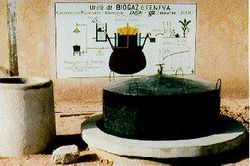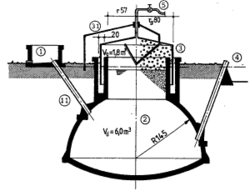Knowledge fuels change - Support energypedia!
For over 10 years, energypedia has been connecting energy experts around the world — helping them share knowledge, learn from each other, and accelerate the global energy transition.
Today, we ask for your support to keep this platform free and accessible to all.
Even a small contribution makes a big difference! If just 10–20% of our 60,000+ monthly visitors donated the equivalent of a cup of coffee — €5 — Energypedia would be fully funded for a whole year.
Is the knowledge you’ve gained through Energypedia this year worth €5 or more?
Your donation keeps the platform running, helps us create new knowledge products, and contributes directly to achieving SDG 7.
Thank you for your support, your donation, big or small, truly matters!
Floating Drum Biogas Plants
here are different types of small scale biogas digesters. Some of the biogas digesters are summarized below:
The table below gives a first comparision of the different types.
Factors |
Fixed dome |
Floating drum |
Tubular design |
Plastic containers |
|---|---|---|---|---|
Gas storage |
Internal Gas storage up to 20 m³ (large) |
Internal Gas storage drum size (small) |
Internal eventually external plastic bags |
Internal Gas storage drum sizes (small) |
Gas pressure |
Between 60 and 120 mbar |
Upto 20 mbar |
Low, around 2 mbar |
Low around 2mbar |
Skills of contractor |
High; masonry, plumbing |
High; masonry, plumbing, welding |
Medium; plumbing |
Low; plumbing |
Availability of Material |
yes |
yes |
yes |
yes |
Durability |
Very high >20 years |
High; drum is weakness |
Medium; Depending on chosen liner |
Medium
|
Agitation |
Self agitated by Biogas pressure |
Manual steering |
Not possible; plug flow type |
Evtl Manual steering |
Sizing |
6 to 124 m³ digester vol |
Up to 20 m³ |
Combination possible |
Up to 6 m³ digester vol |
Methane emission |
High |
Medium |
Low |
Medium |
Floating Drum Biogas Plants
Floating-drum plants consist of an underground digester and a moving gas-holder. The gas-holder floats either directly on the fermentation slurry or in a water jacket of its own. The gas is collected in the gas drum, which rises or moves down, according to the amount of gas stored. The gas drum is prevented from tilting by a guiding frame. If the drum floats in a water jacket, it cannot get stuck, even in substrate with high solid content.
The Drum
In the past, floating-drum plants were mainly built in India. A floating-drum plant consists of a cylindrical or dome-shaped digester and a moving, floating gas-holder, or drum. The gas-holder floats either directly in the fermenting slurry or in a separate water jacket. The drum in which the biogas collects has an internal and/or external guide frame that provides stability and keeps the drum upright. If biogas is produced, the drum moves up, if gas is consumed, the gas-holder sinks back.
Size
Floating-drum plants are used chiefly for digesting animal and human feces on a continuous-feed mode of operation, i.e. with daily input. They are used most frequently by small- to middle-sized farms (digester size: 5-15m3) or in institutions and larger agro-industrial estates (digester size: 20-100m3). Disadvantages: The steel drum is relatively expensive and maintenance-intensive. Removing rust and painting has to be carried out regularly. The life-time of the drum is short (up to 15 years; in tropical coastal regions about five years). If fibrous substrates are used, the gas-holder shows a tendency to get "stuck" in the resultant floating scum.
Water-jacket Floating-drum Plants
Water-jacket plants are universally applicable and easy to maintain. The drum cannot get stuck in a scum layer, even if the substrate has a high solids content. Water-jacket plants are characterized by a long useful life and a more aesthetic appearance (no dirty gas-holder). Due to their superior sealing of the substrate (hygiene!), they are recommended for use in the fermentation of night soil. The extra cost of the masonry water jacket is relatively modest.
Material of Digester and Drum
The digester is usually made of brick, concrete or quarry-stone masonry with plaster. The gas drum normally consists of 2.5 mm steel sheets for the sides and 2 mm sheets for the top. It has welded-in braces which break up surface scum when the drum rotates. The drum must be protected against corrosion. Suitable coating products are oil paints, synthetic paints and bitumen paints. Correct priming is important. There must be at least two preliminary coats and one topcoat. Coatings of used oil are cheap. They must be renewed monthly. Plastic sheeting stuck to bitumen sealant has not given good results. In coastal regions, repainting is necessary at least once a year, and in dry uplands at least every other year. Gas production will be higher if the drum is painted black or red rather than blue or white, because the digester temperature is increased by solar radiation. Gas drums made of 2 cm wire-mesh-reinforced concrete or fiber-cement must receive a gas-tight internal coating. The gas drum should have a slightly sloping roof, otherwise rainwater will be trapped on it, leading to rust damage. An excessively steep-pitched roof is unnecessarily expensive and the gas in the tip cannot be used because when the drum is resting on the bottom, the gas is no longer under pressure. Floating-drums made of glass-fiber reinforced plastic and high-density polyethylene have been used successfully, but the construction costs are higher compared to using steel. Floating-drums made of wire-mesh-reinforced concrete are liable to hairline cracking and are intrinsically porous. They require a gas-tight, elastic internal coating. PVC drums are unsuitable because they are not resistant to UV.
Guide Frame
The side wall of the gas drum should be just as high as the wall above the support ledge. The floating-drum must not touch the outer walls. It must not tilt, otherwise the coating will be damaged or it will get stuck. For this reason, a floating-drum always requires a guide. This guide frame must be designed in a way that allows the gas drum to be removed for repair. The drum can only be removed if air can flow into it, either by opening the gas outlet or by emptying the water jacket. The floating gas drum can be replaced by a balloon above the digester. This reduces construction costs but in practice problems always arise with the attachment of the balloon to the digester and with the high susceptibility to physical damage.
Types of Floating-drum Plants
There are different types of floating-drum plants:
- KVIC model with a cylindrical digester, the oldest and most widespread floating drum biogas plant from India.
- Pragati model with a hemisphere digester
- Ganesh model made of angular steel and plastic foil
- floating-drum plant made of pre-fabricated reinforced concrete compound units
- floating-drum plant made of fibre-glass reinforced polyester
- low cost floating-drum plants made of plastic water containers or fiberglass drums: ARTI Biogas plants
- BORDA model: The BORDA-plant combines the static advantages of hemispherical digester with the process-stability of the floating-drum and the longer life span of a water jacket plant.
Summary
Advantages: Disadvantages: Disadvantages are high material costs of the steel drum, the susceptibility of steel parts to corrosion. Because of this, floating drum plants have a shorter life span than fixed-dome plants and regular maintenance costs for the painting of the drum.
=





















